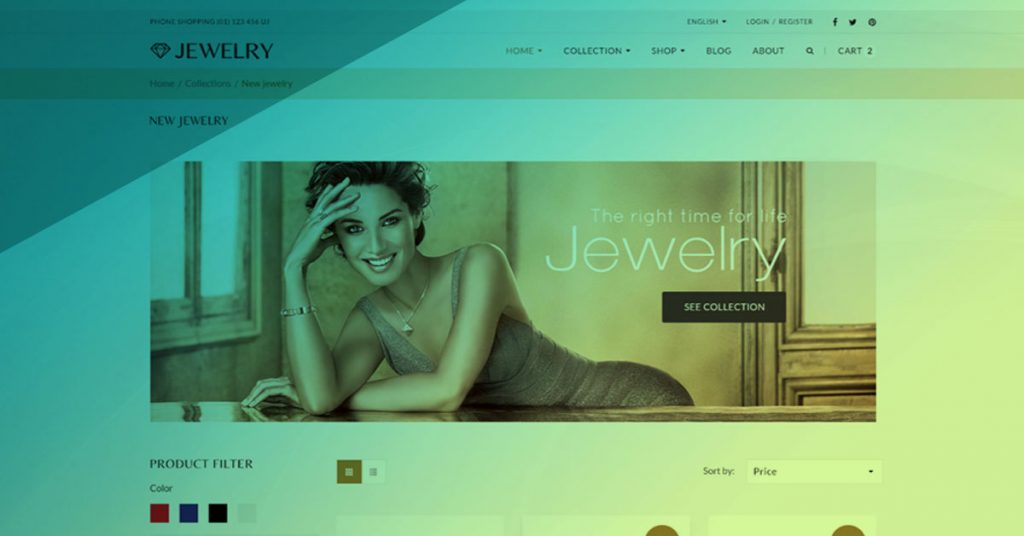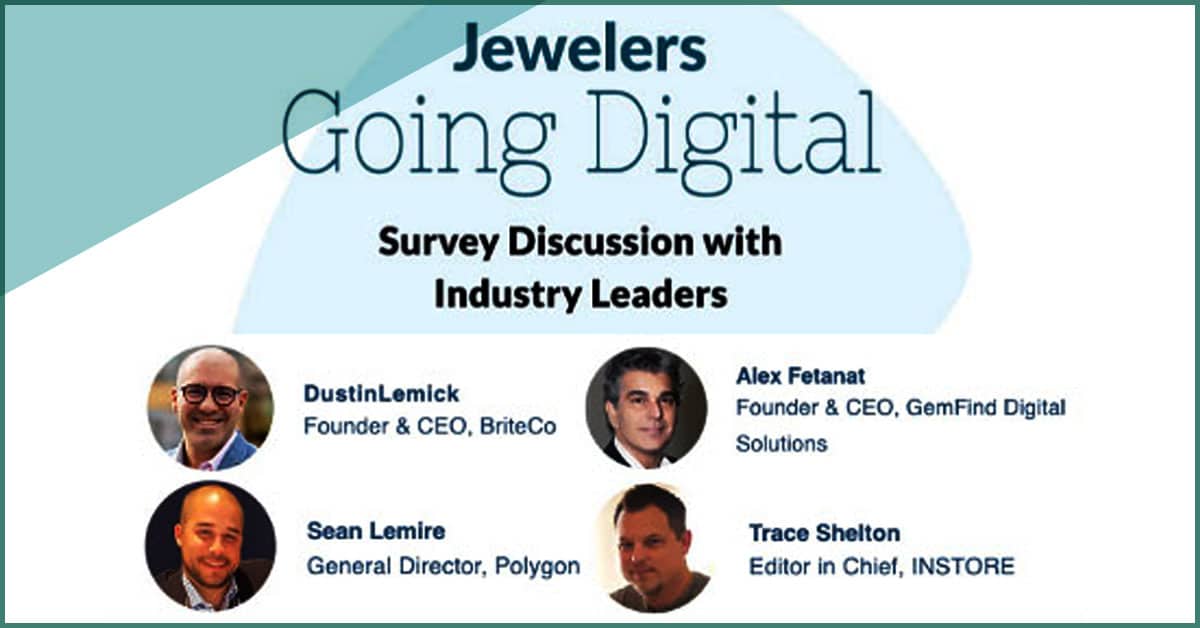Website best practices: Give your jewelry store’s website a makeover
June 11th, 2020A modern, functional website is one of the most powerful tools a retail jeweler can leverage in today’s economy. We’ll walk you through how to set up a website that looks great and functions seamlessly so you can connect with customers and close sales. If you already have a website, you can use these website best practices to freshen up what you have or to give your site a full makeover.
Why do you need a website?
Now more than ever, people are living their lives online. People used to think of tech as something mainly for young people. But today, people of all ages are using technology to work, play, shop, and connect with one another. It is important for you to meet your current and potential customers where they’re spending their time. Make a great impression with a beautiful website!
We recommend creating a holistic plan for your overall online presence, including social media, but in this article we’ll focus specifically on your website. Think of your website as your virtual storefront. If you see a store that looks clean, modern, and bright, you’ll want to go in, right? A website works the same way. If it looks sharp and is easy to use, people will want to spend with it. An outdated website or no website at all could raise red flags and drive people away.
Here are some best practices and steps to build a winning website for your jewelry store.
Start with a strategy
Goals
Before you start planning the details of your website, define your overarching goals for this project and determine what’s possible for you and your team.
What kind of website do you want?
Are you interested in building a marketing site? A marketing website is designed to help visitors get to know you and your brand and possibly learn about news and updates. The goal here is to drive them to make contact with you – or to come into your store. Do you want to create an e-commerce site? An e-commerce site allows visitors to select and purchase items. It requires the capacity to manage and process online orders – is this something you and your team can handle? Maybe you want your website to be both marketing and e-commerce. Establish your goals upfront so that all of the work you put into this project will ultimately meet your needs.
How will you know if your website is successful?
Taking your goals into consideration, think about how to measure the success of your website. Is it traffic to the site? Number of virtual interactions with visitors? Number of sales? Something else? Once your site is up and running, you’ll be able to examine metrics that track your goals to figure out if your site is working or if you need to make some tweaks.
Brand
In order to build a great website, you have to figure out how you want others to perceive you. This is your brand.
Starting with the basics, does your jewelry store have a logo? Do you have colors that you use in your store and on your printed materials? Digging a little deeper, think about the vibe you want to project. Do you want to come off as super polished and high-end or more approachable and laidback? Are you more traditional or eclectic? This article walks you through how to create a brand for your business. You can also reach out to your network to see if someone has the expertise to help you develop your brand. Keep in mind that some web developers are also trained to do this kind of design work, so you might be able to hire one person to work with you on the entire process, from designing your brand and site to coding the website itself.
Decide how you want to build your site
Once you have some ideas about what you’re trying to achieve and how you want your business to come across to customers, it’s time to get started on your website. There are a few ways to approach this:
Hire a web developer
You can hire an individual or business to build your website for you. This is a great way to support a small business and to get a dedicated expert who can lead you through the process. Another option is to check a website like Upwork or Fiverr. These are great digital marketplaces to connect with talented professionals. Just be extra diligent in background checking to make sure they’re the right fit for you. Here are a few pro tips for choosing the right developer for your project:
Consider what you need from them.
Some web developers can lead design work and branding and offer you creative concepts, while others will depend on you to set the vision and will take your direction very literally, without injecting any input of their own. Neither is good or bad; you’ll just want to find someone who will provide the right balance to the skills you already have on your team.
Ask around.
Once you know what you’re looking for, ask people you know for recommendations. If you see a website you love, reach out to the business owner to find out who built it for them. After you compile a list of contenders, get a few proposals so that you know you’re getting exactly what you need for a reasonable price.
Check references.
If you’re finding someone through your own searches online, check Google, Facebook, Yelp, and other online review sites to learn about others’ experiences working with them. Ask to be put in touch with previous clients of theirs so that you can get the scoop on what working with them is like.
Use a service especially for jewelers
There are many businesses out there that specialize in creating websites for retail jewelers. Choosing one of them could be especially efficient because they’ll already understand your needs and goals and how your industry operates. If you Google “websites for jewelers” you’ll see tons of these specialty businesses that are geared toward helping jewelers like you. Here’s something to keep in mind, though – many jewelers use these services, so your website might end up looking a little bit like everyone else’s. If you’re aiming for something unique, this would not be your best bet.
DIY
If you like to take matters into your own hands and try new things, you might consider a user-friendly online service that will empower you to build your own website without knowing how to code. A few popular website platforms are Wix, Squarespace, and Weebly. This can be a very cost-effective way to create a website that fits your current needs and will grow with your business.
No matter which route you take to build it, be sure to optimize your website for mobile devices. This is really important for both user experience and search engine optimization (SEO)! If you’re interested in learning more about SEO, here’s a handy starter guide. When choosing someone to build your website, make sure to pick someone who has experience and can build your site for effective SEO.
Make it functional
Your site has to look great, and just as importantly, it has to work well. It should contain useful, clear, searchable information so that your customers can get what they need. If this feels overwhelming to you, don’t worry! There are tons of great jewelry websites out there. Take a look at what some of your fellow jewelers are doing, and get inspired; there’s no need to reinvent the wheel! Another great way to organize your ideas about what to include in your website is to take pen to paper. Draw out the individual pages you want on your website, and arrange them to reflect how you want it all organized. You can keep your sketches super simple, or you can create some more detailed wireframes to help you visualize and communicate where you’re going.
Here are the key elements to include in your website:
Inventory
There are so many ways to organize your virtual inventory, but above all, make it easy to browse or search. Each item should have high-quality photos and lots of details. You might even organize your website the same way you organize the cases in your physical store, if you have a system that works! Here are some categories to include:
- Designers or Collections
- Jewelry
- Bracelets
- Earrings
- Necklaces
- Rings
- Other creative categories, like Hot Trends, What’s New, Vintage
- Watches
- Engagement and Bridal
- Gift categories, broken down by occasions and price points
Multiple ways to interact with you
Make it easy for a website visitor to get in touch with you.
Chat software, like JivoChat.
Great retail websites build in chat software so that a customer can seamlessly interact with you while they’re on your site. This usually shows up as a little pop-up in the bottom corner. Just be sure to monitor it so that you don’t leave your visitors hanging! You can even set it to alert you on your smartphone if you want to engage with customers who reach out after hours.
A contact form.
Collect name, email, phone number, find how they want you to respond (a simple dropdown will do), and give them space to ask a question. When they click “Submit,” they should get an automated message letting them know when to expect a response; for example, in the next business day.
Old-fashioned contact info.
Post your address, phone number, and email in a place that’s easy to find. You might even consider embedding your contact info in the header or footer of the website so that it shows up on each page.
Other information to include
There are so many ways to tell your jewelry store’s story through your website. Here are some other topics to include:
About us.
People buy from people. Tell your visitors who you are and why you love the jewelry business. In addition to your store’s history, you might also include info about your staff. It will make your business feel personal to your visitor. Bonus points for great photos!
Services.
Do you offer repair? Custom work? Appraisals? Financing? Trade-in programs? Let people know what you offer in addition to jewelry and watches. If you partner with organizations like BriteCo to offer jewelry insurance, this is the perfect place to mention them.
Education.
There is so much to know about jewelry, and visitors to your website might be first-time jewelry buyers. Create informative guides or helpful checklists so that they feel empowered to make smart decisions. Providing transparent information can relieve their anxiety and build trust with you, and then they’ll be more comfortable making a purchase.
Miscellaneous.
A few more ideas:
- A sign-up form if you have an e-newsletter
- Links to your social media accounts
- Testimonials
- Information about ordering online and shipping
- Policies (returns, etc)
- Testimonials and reviews from happy customers
- A place for them to share feedback with you directly
- FAQs
- Credentials (for example, IJO or RJO logos)
A great website will give customers a chance to get to know you before they walk in your door. Put your best foot forward by following these best practices, and you’ll attract more well-informed customers who want to buy jewelry from you!










